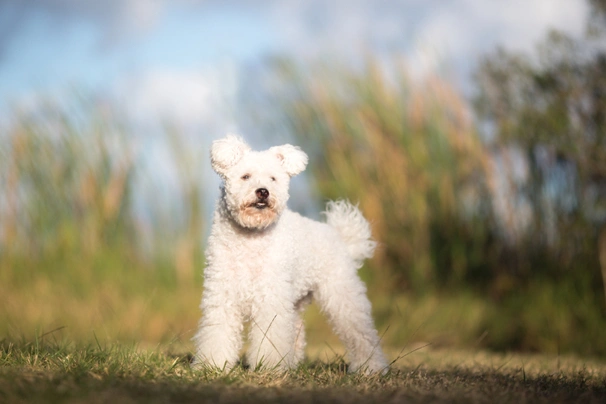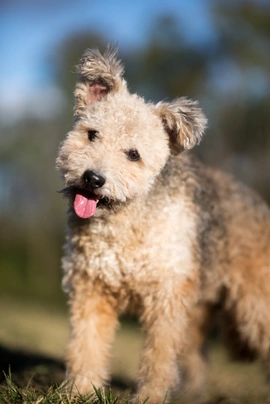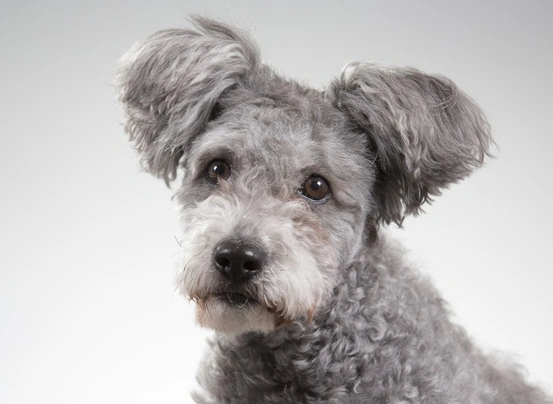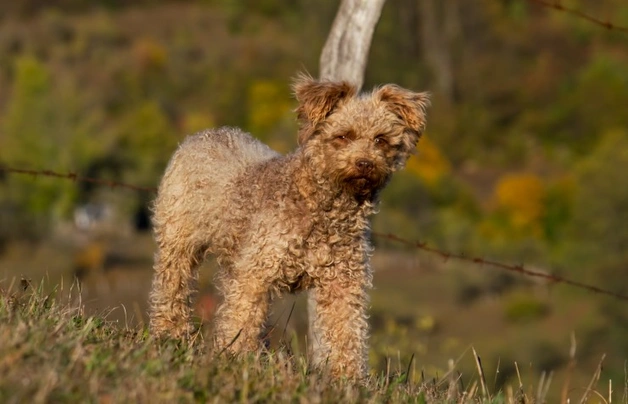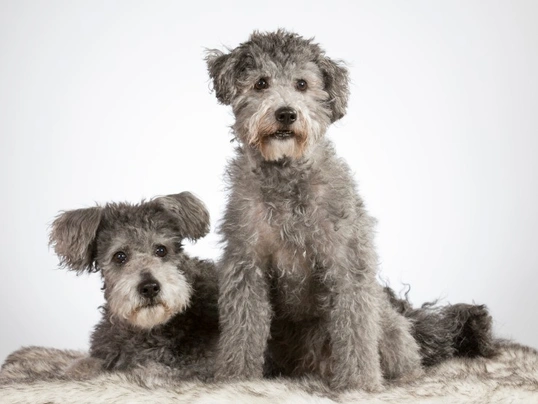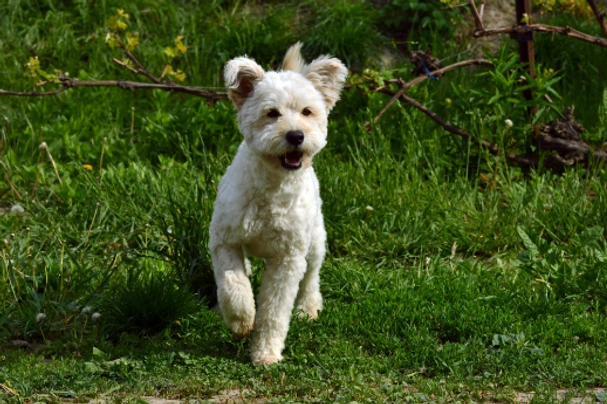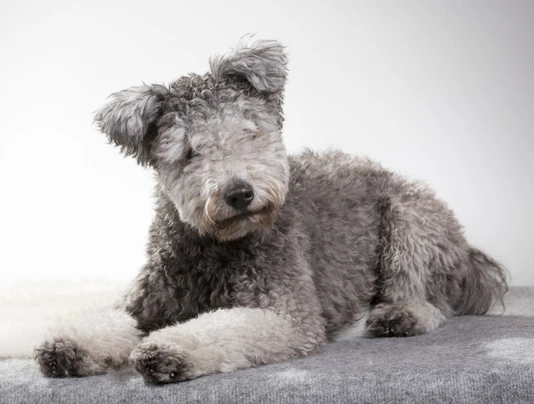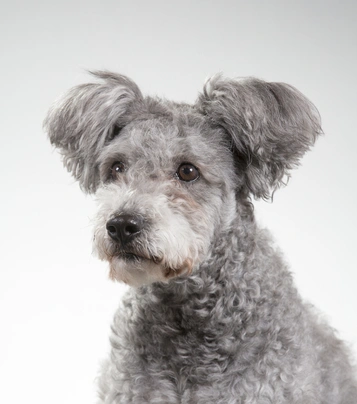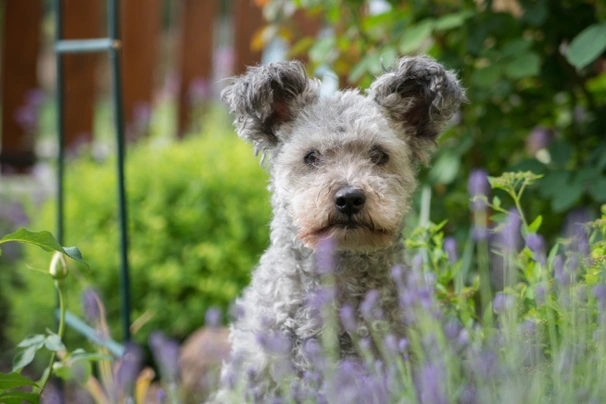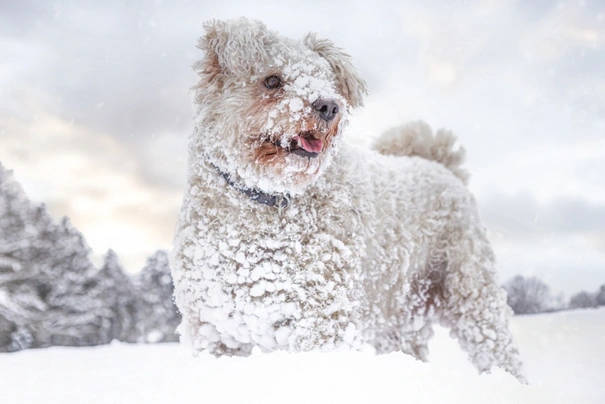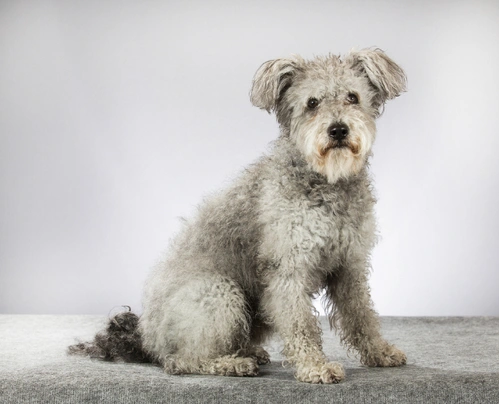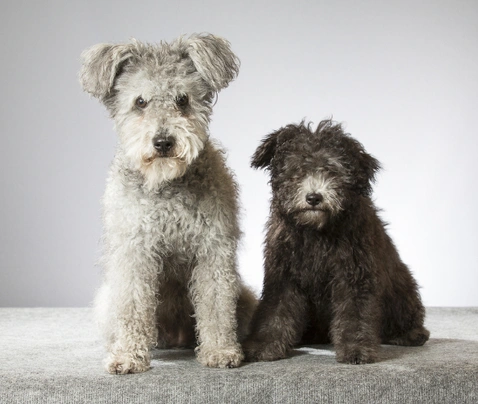Hungarian Pumi
Pros
Cons
Introduction of the Hungarian Pumi
Hungarian Pumik are unique looking medium sized dogs that over recent years have found a fanbase in the UK and elsewhere in the world. They are intelligent active and loyal medium sized dogs that thrive on having something to do. Pumik form strong bonds with their families which includes children and are always eager to play interactive games with them.
Although the Pumi has always been one of the more popular breeds in their native Hungary it is only relatively recently that they have made a mark outside of the country as more people become familiar with the breed. Today the Hungarian Pumi is recognised by the Kennel Club but anyone wanting to share a home with a Pumi would need to register their interest with breeders and go on a waiting list for the pleasure of doing so.
History of the Hungarian Pumi
The Hungarian Pumi has an illustrious history having been introduced to Europe along with many other herding dogs by the Magyars as they moved their large herds of livestock to new grazing grounds. It is thought that these herding dogs can trace their ancestry back to the Tibetan herding dogs which includes the Tsang Apso which is a breed that was native to both Tibet and China.
It was during the early twentieth century that the Hungarians established that there were 3 separate breeds native to the country namely the Puli the Pumi and the Mudi. The Puli was developed on the eastern plains whereas the Pumi was developed in the west. The Mudi was a herding dog developed in the south of the country. Enthusiasts believe that the Pumi is in fact a variation of the Puli and that for centuries both names were used to describe each of the breeds.
A breed standard was first drawn up for the Pumi and the Puli at the beginning of the 1900s by Emil Raitsits. It was later updated in the 1920’s with the Pumi’s standard having been recognised by the FCI in American a few years later in 1935. It was in the early breed standard that many other breeds were recorded as contributing to the development of the Pumi which contributed to their appearance. Pumik began to have longer muzzles and more level toplines with upright terrier-like ears. Their coats too were different to that of their Puli counterparts.
The Hungarian Pumi was developed to herd livestock which includes sheep goats pigs and cattle and are still used as herding dogs in Hungary today. Pumik were bred to use their voices when driving flocks and herds while at the same time “nipping” at heels to move them along when needed. They were also used to guard farms and other properties a job they excel at.
Interesting facts about the breed
- Is the Hungarian Pumi a vulnerable breed? No although quite rare in the UK with well-bred Kennel Club registered puppies often commanding a lot of money and waiting lists tend to be long
- The Hungarian Pumi was bred as a herding dog with many “terrier” traits
- They have very well developed scenting abilities
- They are known to be a very active and capable “sporting” breed
- Although Hungarian Pumik are often described as “a Hungarian herding Terrier” they do not have any terrier in them. It just describes their terrier-like quick and alert personalities and their looks
Appearance of the Hungarian Pumi
Height at the withers: Males 41 – 47 cm Females 38 – 44 cm
Average Weight: Males 10 – 15 kg Females 8 – 13 kg
Hungarian Pumik are medium sized dogs. They have sturdy well-muscled bodies yet dogs are fine boned. They have quite a square outline and dogs carry their heads proudly. One of their most striking features is their upright ears that have the top part falling forwards. Their heads are quite long and narrow with Pumik having long muzzles. When seen from the front the top of a dog’s skull is slightly domed and relatively broad. Foreheads are long and only a little domed but appear to be flat when viewed from the side.
Forefaces are virtually straight with only the slightest stop apparent. Their forefaces are quite narrow and taper toward the nose before finishing abruptly. Bridges are straight and noses are black regardless of a dog’s coat colour. Their eyes are set quite wide apart and a little obliquely being oval shaped and medium in size. Eyes are a dark brown with the Pumi always having an alert intelligent expression in them. Their eyelids fit tightly and are a dark pigment.
Their ears are set high on a dog’s head with the upper third of the ear falling forwards. Ears are nicely coated moderately large and triangular with dogs carrying them erect and which are always mobile displaying an alertness to what is going on around them.
The Pumi has a strong jaw with strong teeth and a perfect scissor bite where their upper teeth overlap their lower teeth. The roof of the mouth can be dark or variegated with dogs having deep pigmented spots on a dark base. Lips are tight being darkly pigmented. Their necks are moderately long and well-muscled with dogs holding them a little arched. The skin on a dog’s throat is tight with no loose skin evident.
Their shoulders are well-laid and long with dogs having prominent withers that are set directly over the deepest point of their brisket. Upper arms slope well back to a dog’s close fitting elbows. Forearms are long and lean with dogs having quite straight pasterns. Front legs are straight being long and lean being set well under a dog’s body and never too wide apart.
The Pumi’s body is well muscled and lean with dogs having nice level toplines. Their backs are short taut and straight. Loins are firmly coupled being short and straight with dogs having short slightly sloping croups. Fore chests are never too broad and quite deep reaching well down to a dog’s elbows. Bellies are tight and nicely tucked up towards the rear. Their rib cages are only slightly rounded being quite flat.
Back legs are powerful and strong being moderately angulated without even showing any exaggeration. When viewed from the side a dog’s back legs extend somewhat to the point of the buttock. Seen from behind their legs are parallel being straight but never too narrow nor too wide. Upper thighs are well-muscled with dogs having long lower thighs and well-defined lean low set hocks. They have nicely rounded cat-like fee with toes being well-knit and nicely cushioned paw pads. Nails are strong and can be either black or slate in colour. Tails are set high which dogs carry upright with curls forming a distinct circle towards a dog’s croup. The hair on the underside is long and wiry which stands off and which has a little undercoat. Tails curl high over a dog’s croup.
When it comes to their coat the Hungarian Pumi has a medium length wavy or curly coat which is shaggy elastic and dense. Their coats consist of a crisp strong top coat that is never coarse with dogs having a much softer undercoat. Their coats must never be smooth matted or corded. Dogs have thick wiry and slightly longer hair on their ears but eyes and forefaces have short hair. The accepted colours for Kennel Club registration are as follows:
- Black
- Dark Grey
- Fawn
- Grey
- Light Grey
- White
It is worth noting that the accepted breed colours for Kennel Club registration can differ from those set out in the breed standard which are as follows:
- Grey – various shades with puppies being born with black coats
- Black
- White –intense and solid
- Fawn – referred to as fako in Hungary primary colours being red yellow cream with a trace of black or grey and a distinct mask being desirable
Dogs can have a white mark on the chest and/or white hairs on their toes which is allowed under the KC breed standard. Skin in all coat colours must be well pigmented being black or slate grey.
Gait/movement
When a Hungarian Pumi moves they do so with a lively spirited light gait taking short energetic balanced strides. Dogs place their back feet well into the footprints of their front feet.
Faults
The Kennel Club frowns on any exaggerations or departures from the breed standard and would judge the faults on how much they affect a dog's overall health and wellbeing as well as their ability to perform.
Males should have both testicles fully descended into their scrotums and it is worth noting that a dog can be a little lighter or heavier as well as slightly taller or shorter than set out in the Kennel Club breed standard which is only given as a guideline.
Temperament of the Hungarian Pumi
The Hungarian Pumi is an intelligent affectionate fun-loving energetic dog that thrives on being lots of daily physical exercise. Being so smart they also need a lot of mental stimulation for them to be truly happy well-balanced dogs. Bred to herd they are better suited to people who are familiar with the specific needs of this type of working dog. In short a Pumi is not the best choice for novice dog owners because their canine companion might get the better of them.
The Pumi thrives in a home environment providing they are given lots to do and never left to their own devices for any length of time which could see them becoming destructive around the home. They excel at all sorts of canine sports which includes activities like agility tracking and obedience to name but three. Although they form strong ties with the whole family a Hungarian Pumi bonds with one member more than others which is typically the person who takes the most care of them.
Are they a good choice for first time owners?
Although always eager to please the Pumi is not the best choice for first time dog owners because they need to be socialised handled and trained by people who are familiar with the specific needs of a highly intelligent energetic herding dog and one that likes to be kept busy. They are better suited to people who lead active outdoor lives who would like an energetic canine companion at their side.
What about prey drive?
Hungarian Pumi are social by nature but they have a high prey drive and will happily chase anything that tries to run away from them or which they spot in the distance and this includes the next door neighbour’s cat. As such care must be taken as to where and when a Pumi can run off the lead more especially if there is livestock or wildlife close by.
What about playfulness?
The Pumi is known to have a very playful side to their nature. They love to entertain and be entertained although they can be a little mischievous when the mood takes them. Being so smart a Pumi quickly learns what pleases an owner and how to get their own way.
What about adaptability?
Although medium in size a Pumi is better suited to households with well-fenced secure back gardens they can safely roam in whenever possible to really let off steam. As such they are not the best choice for people who live in an apartment in town.
What about separation anxiety?
A Hungarian Pumi forms a very strong bond with their families and more especially to the person who takes the most care of them. They are never happy when they find themselves left on their own for longer periods of time. They are better suited to people who either work from home or in households where one person stays at home when everyone else is out so they are never alone for any length of time which could see a dog suffering from separation anxiety. This can lead to them being destructive around the home which is a dog's way of relieving any stress they are feeling and a way to keep themselves entertained.
What about excessive barking?
The Pumi is known to like the sound of their own voices a little too much bearing in mind that they were bred to “bark” when herding flocks and herds of livestock. In short it is a trait that is deeply embedded in their psyche and which must not be encouraged when a Pumi is young to avoid it becoming a nuisance later on.
Do Hungarian Pumik like water?
Most Pumik like getting their feet wet and will take to the water whenever they can more especially when the weather is hot. However if anyone who owns a dog that does not like water should never force them to go in because it would just end up scaring them. With this said care should always be taken when walking a Pumi off the lead anywhere near more dangerous watercourses just in case a dog decides to leap in and then needs rescuing because they cannot get out of the water on their own.
Are Hungarian Pumik good watchdogs?
Hungarian Pumik are natural watchdogs having been bred to herd and guard flocks of livestock and guard farms for centuries. However rarely would a Pumi show any sort of aggressive behaviour preferring to stand their ground and bark.
Intelligence / Trainability of the Hungarian Pumi
The Pumi is a highly intelligent dog and one that learns things quickly which includes the “good” and the “bad”. They are known to assess a situation before reacting to it which is why it’s a good idea to expose a young puppy to as many new situations as possible. With this said they are always eager to please and in the right hands they are highly trainable. They take part in lots of canine sports which includes agility obedience and tracking.
Like all puppies Pumik are incredibly cute when young and it is all too easy to spoil them when they first arrive in new homes. As soon as a puppy is nicely settled owners must start out as they mean to go on by laying down ground rules and boundaries so that a puppy understands what is expected of them. It helps establish a pecking order and who the alpha dog is in the household. The first commands a puppy should be taught are as follows:
- Come
- Sit
- Stay
- Heel
- Quiet
- Leave it
- Down
- Bed
Children and other
The Hungarian Pumi thrives in a family environment forming strong ties with the children in a household. They can be suspicious of children they don’t already know and any interaction should always be well supervised by an adult to make sure things stay nice and calm.
They are also known to get on with a family cat but would happily chase other pets and animals if they get the chance. As such care should always be taken when a Pumi is around any animals they have never met before.
Health of the Hungarian Pumi
The Hungarian Pumi is known to be a healthy breed but like many other pedigree dogs they are prone to inheriting some health issues which are worth knowing about when thinking of sharing a home with a Pumi.
The health concerns that appear to affect the Hungarian Pumi the most are as follows:
- Hip dysplasia – dogs should be hip scored by a BVA registered vet or through the Animal Health Trust (AHT)
- Primary lens luxation (PLL) – puppies should be eye tested when they are between 6 to 8 weeks old
- Degenerative myelopathy (DM) – dogs should be tested through the Animal Health Trust (AHT)
- Patellar luxation
What about vaccinations?
Hungarian Pumi puppies would have been given their initial vaccinations before being sold but it is up to their new owners to make sure they have their follow-up shots in a timely manner with the vaccination schedule for puppies being as follows:
- 10 -12 weeks old bearing in mind that a puppy would not have full protection straight away but would be fully protected 2 weeks after they have had their second vaccination
There has been a lot of discussion about the need for dogs to have boosters. As such it's best to talk to a vet before making a final decision on whether a dog should continue to have annual vaccinations which are known as boosters.
What about spaying and neutering?
A lot of vets these days recommend waiting until dogs are slightly older before spaying and neutering them which means they are more mature before undergoing the procedures. As such they advise neutering males and spaying females when they are between the ages of 6 to 9 months old and sometimes even when a dog is 12 months old.
Other vets recommend spaying and neutering dogs when they are 6 months old but never any earlier unless for medical reasons. With this said many breeds are different and it is always advisable to discuss things with a vet and then follow their advice on when a dog should be spayed or neutered.
What about obesity problems?
As with other breeds some Pumi gain weight after they have been spayed or neutered and it's important to keep an eye on a dog's waistline just in case they do. If a dog starts to put on weight it's important to adjust their daily calorie intake and to up the amount of exercise they are given. Older dogs too are more prone to gaining weight and again it's essential they be fed and exercised accordingly because obesity can shorten a dog's life by several years. The reason being that it puts a lot of extra strain on a dog's internal organs including the heart which could prove fatal.
What about allergies?
Hungarian Pumik are not known to suffer from allergies but it's important for a dog to see a vet sooner rather than later if one flares up. Allergies can be notoriously hard to clear up and finding the triggers can be challenging. With this said a vet would be able to make a dog with an allergy more comfortable while they try to find out the triggers which could include the following:
- Certain dog foods that contain high levels of grains and other cereal-type fillers
- Airborne pollens
- Dust mites
- Environment
- Flea and tick bites
- Chemicals found in everyday household cleaning products
Participating in health schemes
All responsible Hungarian Pumi breeders would ensure that their stud dogs are tested for known hereditary and congenital health issues known to affect the breed by using the following schemes:
- Hip scoring by a BVA registered vet or through the Animal Health Trust (AHT)
- Eye testing – puppies should be tested when they are between 6 to 8 weeks old
- Degenerative myelopathy (DM) – dogs should be tested through the Animal Health Trust (AHT)
What about breed specific breeding restrictions?
Apart from the standard breeding restrictions that are in place for all Kennel Club registered breeds there are no other breed specific breeding restrictions in place for the Hungarian Pumi.
What about Assured Breeder Requirements?
Currently there are no Assured Breeder requirements in place for the Hungarian Pumi but all breeders should follow the KC breeding guidelines to ensure they produce healthy puppies.
Caring for the Hungarian Pumi
As with any other breed Pumik must be groomed on a regular basis to make sure their coats and skin are kept in top condition. They also need to be given regular daily exercise to ensure they remain fit and healthy. On top of this dogs need to be fed good quality food that meets all their nutritional needs throughout their lives being careful not to overfeed them and to give them enough daily exercise to burn off calorie intake.
Caring for a Hungarian Pumi puppy
Pumi puppies are boisterous and full of life which means it's essential for homes and gardens to be puppy-proofed well in advance of their arrival. A responsible breeder would have well socialised their puppies which always leads to more outgoing confident and friendly dogs right from the word go. With this said any puppy is going to feel vulnerable when they leave their mother and littermates which must be taken into account. The longer a puppy can remain with their mother the better although it should never be for too long either.
It's best to pick a puppy up when people are going to be around for the first week or so which is the time needed for a puppy to settle in. Puppy-proofing the home and garden means putting away any tools and other implements that a boisterous puppy might injure themselves on. Electric wires and cables must be put out of their reach because puppies love chewing on things. Toxic plants should be removed from flowerbeds and the home too.
Puppies need to sleep a lot to grow and develop as they should which means setting up a quiet area that's not too out of the way means they can retreat to it when they want to nap and it's important not to disturb them when they are sleeping. It's also a good idea to keep "playtime" nice and calm inside the house and to have a more active "playtime" outside in the garden which means puppies quickly learn to be less boisterous when they are inside.
The documentation a breeder provides for a puppy must have all the details of their worming date and the product used as well as the information relating to their microchip. It is essential for puppies to be wormed again keeping to a schedule which is as follows:
- Puppies should be wormed at 6 months old
- They need to be wormed again when they are 8 months old
- Puppies should be wormed when they are 10 months old
- They need to be wormed when they are 12 months old
Things you'll need for your puppy
There are certain items that new owners need to already have in the home prior to bringing a new puppy home. It's often a good idea to restrict how much space a puppy plays in more especially when you can't keep an eye on what they get up to bearing in mind that puppies are often quite boisterous which means investing in puppy gates or a large enough playpen that allows a puppy the room to express themselves while keeping them safe too. The items needed are therefore as follows:
- Good quality puppy or baby gates to fit on doors
- A good well-made playpen that's large enough for a puppy to play in so they can really express themselves as puppies like to do
- Lots of well-made toys which must include good quality chews suitable for puppies to gnaw on bearing in mind that a puppy will start teething anything from when they are 3 to 8 months old
- Good quality feed and water bowls which ideally should be ceramic rather than plastic or metal
- A grooming glove
- A slicker brush or soft bristle brush
- Dog specific toothpaste and a toothbrush
- Scissors with rounded ends
- Nail clippers
- Puppy shampoo and conditioner which must be specifically formulated for use on dogs
- A well-made dog collar or harness
- A couple of strong dog leads
- A well-made dog bed that's not too small or too big
- A well-made dog crate for use in the car and in the home that's large enough for a puppy to move around in
- Baby blankets to put in your puppy's crate and in their beds for when they want to nap or go to sleep at night
Keeping the noise down
All puppies are sensitive to noise including Pumi puppies. It's important to keep the noise levels down when a new puppy arrives in the home. TVs and music should not be played too loud which could end up stressing a small puppy out making them withdrawn timid and shy.
Keeping vet appointments
As previously mentioned Pumi puppies would have been given their first vaccinations by the breeders but they must have their follow up shots which is up to their new owners to organise. The vaccination schedule for puppies is as follows:
- 10 -12 weeks old bearing in mind that a puppy would not have full protection straight away but would only be fully protected 2 weeks after they have had their second vaccination
When it comes to boosters it's best to discuss these with a vet because there is a lot of debate about whether a dog really needs them after a certain time. However if a dog ever needed to go into kennels their vaccinations would need to be fully up to date.
What about older Hungarian Pumi when they reach their senior years?
Older Pumi need lots of special care because as they reach their golden years they are more at risk of developing certain health concerns. Physically a dog's muzzle may start to go grey but there will be other noticeable changes too which includes the following:
- Coats become coarser
- A loss of muscle tone
- They can either become overweight or underweight
- They have reduced strength and stamina
- Older dogs have difficulty regulating their body temperature
- They often develop arthritis
- Immune systems do not work as efficiently as they once did which means dogs are more susceptible to infections
- Older dogs change mentally too which means their response time tends to be slower as such they develop the following:
- They respond less to external stimuli due to impaired vision or hearing
- They tend to be a little pickier about their food
- They have a lower pain threshold
- Become intolerant of any change
- Often an older dog can feel disorientated
Living with a Hungarian Pumi in their golden years means taking on a few more responsibilities but these are easily managed and should include looking at their diet the amount of exercise they are given how often their dog beds need changing and keeping an eye on the condition of their teeth.
Older dogs need to be fed a good quality diet that meets their needs at this stage of their lives all the while keeping a close eye on a dog's weight. A rough feeding guide for older dogs is as follows bearing in mind they should be fed highly digestible food that does not contain any additives:
- Protein content should be anything from 14 – 21%
- Fat content should be less than 10%
- Fibre content should be less than 4%
- Calcium content should be 0.5 – 0.8%
- Phosphorous content should be 0.4 – 0.7%
- Sodium content should be 0.2 – 0.4%
Older Pumi don't need the same amount of daily exercise as a younger dog but they still need the right amount of physical activity to maintain muscle tone and to prevent a dog from putting on too much weight. All dogs need access to fresh clean water and this is especially true of older dogs when they reach their golden years because they are more at risk of developing kidney disorders.
Grooming of the Hungarian Pumi
A Pumi’s coat is made of 50% soft hair with the other 50% being that much harsher in texture. They need to be combed and never “brushed” at least every 2 to 3 weeks to keep things tidy and in good condition. Once combed their coats should be wetted down which allows the curls to form again. Their coats can be trimmed and should never be blown out with a hairdryer.
Exercise of the Hungarian Pumi
Being high-energy active dogs that were bred to herd a Hungarian Pumi needs a lot of daily physical exercise combined with as much mental stimulation as possible to be truly happy well-balanced dogs. As such they need anything from 40 to 60 minutes exercise a day with a shorter walk in the morning and a longer one in the evening and lots of mental stimulation throughout the day.
Pumik excel at all sorts of canine sports which includes lure coursing obedience Frisbee scent work agility heelwork to music and herding activities. They love to please which means in the right hands a Pumi is highly trainable and a quick learner.
With this said young Pumi puppies should not be given too much exercise and this includes being allowed to jump up or down from furniture running up and down stairs because their joints and bones are still growing and too much pressure on them could result in causing a dog a few problems later in their lives.
Feeding of the Hungarian Pumi
If you get a Pumi puppy from a breeder they would give you a feeding schedule and it's important to stick to the same routine feeding the same puppy food to avoid any tummy upsets. You can change a puppy's diet but this needs to be done very gradually always making sure they don't develop any digestive upsets and if they do it's best to put them back on their original diet and to discuss things with the vet before attempting to change it again.
Older dogs can be fussy and finicky about their food but it’s important not to pamper them too much and instead discuss things with a vet. It's best to feed a mature dog twice a day once in the morning and then again in the evening making sure it's good quality food that meets all their nutritional requirements. It's also important that dogs be given the right amount of exercise so they burn off any excess calories or they might gain too much weight which can lead to all sorts of health issues. Obesity can shorten a dog's life by several years so it's important to keep an eye on their waistline from the word go.
Feeding guide for a Hungarian Pumi puppy
Puppies need to be fed a highly nutritious good quality diet for them to develop and grow as they should. As a rough guide a Pumi puppy can be fed the following amounts every day making sure their meals are evenly spread out throughout the day and it's best to feed them 3 or 4 times a day:
- 2 months old - 56 g to 112 g depending on a puppy's build
- 3 months old - 65 g to 139 g depending on a puppy's build
- 4 months old - 68 g to 160 g depending on a puppy's build
- 5 months old - 68 g to 163 g depending on a puppy's build
- 6 months old - 61 g to 163 g depending on a puppy's build
- 7 months old - 54 g to 144 g depending on a puppy's build
- 8 months old - 46 g to 126 g depending on a puppy's build
- 9 months old - 46 g to 109 g depending on a puppy's build
- 10 months old - 45 g to 108 g depending on a puppy’s build
Once a puppy is 12 months old they can be fed adult dog food.
Feeding guide for an adult Hungarian Pumi
Once fully mature an adult Pumi should be fed a good quality diet to ensure their continued good health. As a rough guide an adult dog can be fed the following amounts every day:
- Dogs weighing 8 kg can be fed 114g to 174g depending on activity
- Dogs weighing 10 kg can be fed 135g to 206g depending on activity
- Dogs weighing 13 kg can be fed 155g to 226g depending on activity
- Dogs weighing 15 kg can be fed 175g to 246g depending on activity
Hungarian Pumi price
If you are looking to buy a Hungarian Pumi you would need to pay anything from £500 to over £900 for a healthy well-bred Kennel Club registered puppy. The cost of insuring a male 3-year-old Hungarian Pumi in northern England would be £16.66 a month for basic cover but for a lifetime policy this would set you back £44.40 a month (quote as of June 2018). When insurance companies calculate a pet's premium they factor in several things which includes where you live in the UK and a dog's age and whether they have been neutered or spayed amongst other things.
When it comes to food costs you need to buy the best quality food whether wet or dry to feed your dog throughout their lives making sure it suits the different stages of their lives. This would set you back between £20 - £30 a month. On top of this you would need to factor in veterinary costs if you want to share your home with a Hungarian Pumi and this includes their initial vaccinations their annual boosters the cost of neutering or spaying your dog when the time is right and their yearly health checks all of which quickly adds up to over a £800 a year.
As a rough guide the average cost to keep and care for a Hungarian Pumi would be between £50 to £80 a month depending on the level of insurance cover you opt to buy for your dog but this does not include the initial cost of buying a well-bred healthy Kennel Club registered Hungarian Pumi puppy.
Buying advice
When visiting and buying any puppy or dog there are many important things to consider and questions to ask of the breeder/seller. You can read our generic puppy/dog advice here which includes making sure you see the puppy with its mother and to verify that the dog has been wormed and microchipped.
Hungarian Pumi are finding a big fanbase in the UK although few puppies are bred and registered with the Kennel Club every year. As such with Pumik there is specific advice questions and protocols to follow when buying a puppy which are as follows:
- Beware of online scams and how to avoid them. You may see online and other adverts by scammers showing images of beautiful Pumipuppies for sale at very low prices. However the sellers ask buyers for money up front before agreeing to deliver a puppy to a new home. Potential buyers should never buy a puppy unseen and should never pay a deposit or any other money online to a seller. You should always visit the pet at the sellers home to confirm they are genuine and make a note of their address.
- As previously touched upon Pumik are quite rare in the UK. As such some amateur breeders/people breed from a dam far too often to make a quick profit without caring for the welfare of the puppies their dam or the breed in general. Under Kennel Club rules a dam can only produce 4 litters and she must be between a certain age to do so. Anyone wishing to buy a Pumi puppy should think very carefully about who they purchase their puppy from and should always ask to see the relevant paperwork pertaining to a puppy's lineage their vaccinations and their microchipping.
